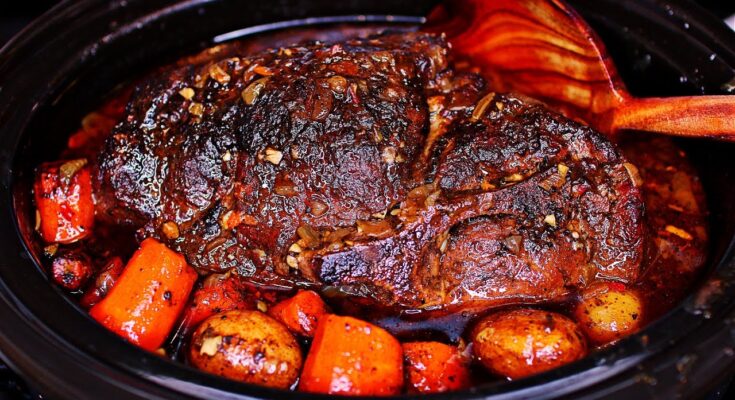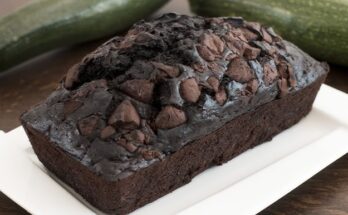Pot Roast Crock Pot Recipe: There’s something undeniably comforting about a tender, flavorful pot roast that’s been simmering away all day in your crock pot.
It’s warm, hearty, and practically melts in your mouth. If you’re looking to create the ultimate crock pot pot roast that tastes like grandma made it – but with a few easy tricks up your sleeve – you’re in the right place.
Whether you’re new to slow cooking or a seasoned pro, this step-by-step guide will walk you through everything you need to know, from the best ingredients to game-changing tips. So, grab your apron, because we’re about to make the best pot roast ever.
Introduction to Pot Roast
What is Pot Roast?
Pot roast isn’t a specific cut of meat—it’s a method of cooking tough cuts of beef low and slow until they’re fork-tender. It’s a classic comfort food dish in many households, typically made with a beef chuck roast, carrots, potatoes, onions, and savory herbs. The roast simmers in broth or wine for hours, infusing it with deep, rich flavor.
The beauty of a pot roast lies in its simplicity. This dish transforms inexpensive cuts of beef into a gourmet-level dinner with just a little patience. It’s the kind of meal that makes the whole house smell amazing and brings everyone to the table without even having to call them.
Why the Crock Pot is Perfect for Pot Roast
The slow cooker—aka crock pot—is basically a pot roast’s best friend. It creates the perfect environment for breaking down the collagen in tougher cuts of meat, turning them incredibly soft and juicy. Unlike oven roasting, it maintains an even, gentle temperature, which helps retain all that wonderful moisture.
Plus, the crock pot is a set-it-and-forget-it kind of magic. You can throw everything in before work and come home to dinner practically made. No constant checking. No babysitting. Just amazing food, ready when you are.
Ingredients You’ll Need
Creating a legendary pot roast starts with using quality ingredients. You don’t need a mile-long grocery list—just a handful of kitchen staples that come together in the most mouthwatering way.
Main Ingredients:
- Beef Chuck Roast (3–5 lbs): This cut has the perfect balance of meat and fat, making it ideal for slow cooking.
- Carrots (3–4 large): Peeled and cut into chunks.
- Potatoes (4–5 medium): Yukon Gold or red potatoes work best. Chop into quarters.
- Onions (1–2 large): Sliced or quartered.
- Garlic (3–5 cloves): Minced or smashed.
- Beef Broth (2 cups): The base for that savory cooking liquid.
- Worcestershire Sauce (2 tbsp): Adds rich umami flavor.
- Olive Oil (2 tbsp): For searing the meat.
- Salt & Pepper: Basic but essential.
- Fresh Herbs: Rosemary, thyme, and bay leaves for aromatics.
Optional Add-Ins for Extra Flavor:
- Red Wine (1/2 cup): Gives the roast a deeper, richer flavor.
- Tomato Paste (1 tbsp): Adds a slight tang and depth.
- Celery (2 stalks): Adds a subtle earthiness.
- Mushrooms: Add umami and soak up the juices.
Feel free to tailor the ingredients based on what you like. Not a fan of potatoes? Swap them for sweet potatoes or parsnips. Want more heat? Add a touch of chili flakes.
Equipment Needed
While a crock pot is the star of this show, a few other tools will make your cooking experience even better.
The Right Crock Pot:
- Size: For a standard 3–5 lb roast, you’ll want at least a 6-quart crock pot.
- Programmable Settings: A timer and “keep warm” function are lifesavers.
- Removable Insert: Easier to clean and sometimes stovetop-safe for searing.
Kitchen Tools That Make It Easier:
- Cast Iron Skillet or Dutch Oven: Ideal for searing meat before adding it to the slow cooker.
- Cutting Board & Sharp Knife: For chopping veggies and trimming meat.
- Tongs: For flipping the roast while searing.
- Meat Thermometer (optional): For checking internal temp if needed.
- Ladle or Slotted Spoon: For serving juicy portions without making a mess.
Investing in quality tools makes a big difference—not just in how the food turns out but in how easy it is to get there.
Step-by-Step Instructions for the Best Crock Pot Pot Roast
Now, let’s get to the real meat of the process (pun intended). Follow these steps, and you’ll have a pot roast that people will rave about.
Step 1: Select and Prep Your Cut of Meat
The best pot roasts start with the right cut of beef. You’re looking for a cut with a decent amount of marbling (fat) that breaks down into juicy tenderness as it cooks.
Best cuts for pot roast:
- Chuck Roast: Most popular choice – tender and flavorful.
- Brisket: Richer but takes a bit longer to cook.
- Round Roast: Leaner, but still a solid option.
When prepping, pat the roast dry with paper towels to help with searing. Trim off any large chunks of fat, but don’t remove it all—you want that marbled fat for flavor. Let the roast come to room temperature for about 20 minutes before cooking so it sears evenly.
Step 2: Seasoning and Searing the Meat
Don’t skip this step—it’s the flavor jackpot.
Seasoning Tips:
- Generously season all sides of the roast with kosher salt and freshly ground black pepper.
- Optional: Rub with garlic powder, onion powder, and smoked paprika for extra depth.
Searing Tips:
- Heat oil in a cast iron skillet over medium-high heat.
- Sear the roast for 4–5 minutes per side, until deeply browned.
- This caramelizes the surface and locks in flavor.
Once seared, transfer the roast to the crock pot and pour any leftover juices from the pan right in.
Step 3: Preparing the Vegetables
When it comes to the supporting cast of your pot roast, veggies play a starring role. Not only do they absorb all that meaty, flavorful broth, but they also help balance out the richness of the dish. Proper prep is essential to ensure everything cooks evenly and nothing turns to mush.
Carrots: Peel and cut them into large chunks. Baby carrots are convenient, but whole carrots sliced into thick pieces hold their shape better during the long cooking time.
Potatoes: Yukon Golds and red potatoes are your best bet—they’re waxy enough to stay firm. Russets tend to fall apart. Cut them into halves or quarters, depending on size.
Onions: Yellow or white onions are ideal. Slice them thick or cut them into quarters. If you love a little sweetness, caramelize them slightly in the skillet before adding them to the pot.
Other Great Additions:
- Celery: Chopped into thick chunks.
- Parsnips or Turnips: Earthy flavors that work wonderfully in hearty dishes.
- Mushrooms: Add them near the end of cooking for the best texture.
Don’t overcrowd the crock pot—veggies should be nestled around the meat, not completely covering it. You want them to simmer, not steam.
Pro Tip: If you like your vegetables a little firmer, consider adding them halfway through the cooking time instead of right at the start.
Step 4: Layering Ingredients in the Crock Pot
Believe it or not, the order in which you layer ingredients can impact how your pot roast turns out.
Here’s the ideal layering method:
- Bottom Layer: Onions, carrots, and potatoes. These vegetables take longer to cook and act as a flavor-packed “bed” for your roast. They also help elevate the meat above the liquid, allowing the juices to circulate.
- Middle Layer: The seared chuck roast goes on top of the veggies.
- Top Layer: Garlic, herbs (rosemary, thyme, bay leaves), and any optional flavor boosters like mushrooms or celery.
Pour the liquid: Mix the beef broth, Worcestershire sauce, and (if using) red wine or tomato paste. Pour it over everything, ensuring the roast is partially submerged but not drowning. The crock pot doesn’t require much liquid—steam does most of the work.
Set the temperature: Cook on LOW for 8–10 hours or on HIGH for 4–6 hours. The low-and-slow method is preferred—it breaks down the connective tissues gradually, giving you that fall-apart tenderness.
Step 5: Slow Cooking to Perfection
This is where the magic happens. Once your pot roast is layered and ready, resist the urge to lift the lid too often. Every time you open it, heat escapes and extends the cooking time.
During the cooking process:
- The meat becomes incredibly tender.
- The vegetables soak up savory juices.
- The broth transforms into a rich, flavorful base.
How do you know when it’s done?
- The roast should be fork-tender—you should be able to pull it apart with minimal effort.
- The internal temperature for doneness is around 195–205°F, which is when the connective tissues fully break down.
Optional Final Touch: Once the cooking is done, remove the meat and vegetables and strain the remaining liquid. You can reduce it in a saucepan for a more concentrated gravy or serve it as is for a rustic au jus.
Serving Suggestions:
- Plate the roast and veggies with a drizzle of gravy.
- Sprinkle fresh herbs on top for color and flavor.
- Serve with crusty bread to soak up the juices.
And just like that, you’ve got a Sunday dinner-worthy pot roast with minimal effort.
Tips for the Juiciest, Most Flavorful Pot Roast
Cooking a great pot roast is part science, part art. Here are some key tips that can take your roast from good to absolutely unforgettable:
Choosing the Right Cut of Meat
- The chuck roast is your best friend here. It’s affordable, marbled, and shreds beautifully when slow-cooked.
- Avoid lean cuts like sirloin—they tend to dry out.
Don’t Skip the Sear
- Browning the meat isn’t just about color—it’s about flavor.
- That crust adds depth to the entire dish and enhances the broth.
Layering is Key
- Keep veggies on the bottom so they cook evenly and don’t get too soft.
- Place meat on top so it bastes in its own juices as it cooks.
Let It Rest Before Serving
- Give your roast 10–15 minutes to rest after cooking. This allows juices to redistribute for maximum tenderness.
Add Fresh Herbs at the End
- A sprinkle of chopped parsley or thyme right before serving adds a burst of freshness.
How to Thicken the Gravy
The flavorful liquid at the bottom of your crock pot can easily be turned into a luscious gravy to pour over your roast and veggies.
Method 1: Cornstarch Slurry
- Remove 1 cup of hot liquid from the crock pot.
- Stir in 1–2 tablespoons of cornstarch until smooth.
- Return it to the pot and stir. Let it cook for another 15–20 minutes until thickened.
Method 2: Make a Roux
- Melt 2 tablespoons of butter in a small saucepan.
- Whisk in 2 tablespoons of flour and cook for 2–3 minutes.
- Slowly whisk in the pot juices and cook until thickened.
Pro Tip: For even more flavor, add a splash of red wine or a teaspoon of soy sauce to your gravy.
Storing and Reheating Leftovers
A great pot roast doesn’t just shine on day one—it’s even better the next day. The flavors have more time to develop, and if you’ve got leftovers, you’re basically meal-prepped without even trying.
How to Store Leftovers
Proper storage helps maintain the roast’s quality and safety.
- In the Fridge: Allow the roast and veggies to cool to room temperature. Then, transfer them to an airtight container. You can store them in the fridge for up to 4 days.
- Separate Liquid: For best results, store the meat and vegetables separately from the cooking liquid or gravy. This keeps them from getting mushy.
- Use Glass Containers: If you plan to reheat in the microwave, glass containers are a safe and easy option.
Can You Freeze It? Absolutely.
- Freezing Instructions:
- Slice or shred the beef.
- Store in a freezer-safe bag or container, along with some of the cooking juices to prevent drying out.
- Label it with the date. It will last for up to 3 months in the freezer.
- To Reheat:
- Thaw overnight in the fridge if frozen.
- Reheat on the stove, in the oven, or in the microwave with a splash of broth to keep it juicy.
Pro Tip: Freeze single-portion servings for easy weeknight dinners or lunches.
Creative Leftover Ideas
Let’s face it—leftovers are only boring if you let them be. Pot roast is incredibly versatile and can be turned into several mouthwatering dishes that feel brand new.
1. Pot Roast Sandwiches
- Slice the leftover meat thin.
- Layer onto toasted hoagie rolls or sourdough with a slice of provolone or cheddar.
- Add caramelized onions or a spoonful of horseradish cream.
- Serve with a side of au jus for dipping—hello, French Dip!
2. Pot Roast Tacos
- Shred the meat.
- Warm in a skillet with a bit of cumin, paprika, and lime juice.
- Serve in corn tortillas with pickled onions, salsa, and avocado.
3. Pot Roast Hash
- Dice leftover roast and potatoes.
- Sauté with onions and bell peppers.
- Crack in an egg and top with fresh herbs—perfect brunch material.
4. Pot Roast Soup
- Toss shredded beef into a pot with leftover gravy, broth, and extra veggies.
- Add some noodles or barley for a cozy, hearty soup.
These aren’t just ways to use leftovers—they’re ways to look forward to them.
Common Mistakes to Avoid
Even with a foolproof recipe, there are a few common missteps that can turn your dreamy pot roast into a dry or bland disappointment. Let’s make sure you avoid them like a boss.
1. Skipping the Sear
This is the #1 mistake. It might seem like an extra step, but searing locks in moisture and builds flavor with that golden crust. Don’t skip it.
2. Using the Wrong Cut
Lean cuts like sirloin or tenderloin may sound fancy, but they’re terrible for pot roast. You need a tough, fatty cut like chuck roast that becomes tender with long cooking.
3. Overcrowding the Crock Pot
Too many veggies or meat packed in tight reduces circulation, making the food cook unevenly. Stick to what fits comfortably with room for juices to move around.
4. Too Much Liquid
You don’t need to submerge the roast. Too much broth can drown the flavor and make everything soupy. A couple of cups is plenty—remember, the crock pot traps steam.
5. Overcooking on High
Yes, it’s tempting to speed things up, but pot roast is a low-and-slow affair. Cooking it on high heat risks drying it out and making it tough. Patience pays off.
Avoid these and your pot roast will hit legendary status every single time.
Nutrition Information
While pot roast is a hearty, satisfying meal, it can also be surprisingly balanced—especially when paired with veggies and smart portion control.
| Nutrient | Amount (Per Serving) |
|---|---|
| Calories | 450–600 kcal |
| Protein | 35–45g |
| Carbohydrates | 25–30g |
| Fat | 25–35g |
| Fiber | 3–5g |
| Sodium | 700–900mg |
Healthier Swaps:
- Less Sodium: Use low-sodium broth and skip the extra salt.
- More Veggies: Double up on carrots, celery, and add greens like kale near the end.
- Lean Cuts: Choose a well-trimmed chuck roast and skim off fat from the cooking juices.
- Whole Ingredients: Avoid pre-packaged flavor packets. Use fresh herbs and natural seasonings.
Pot roast doesn’t have to be a cheat meal—it can fit into a well-rounded, delicious lifestyle.
FAQs about Pot Roast Crock Pot Recipe
1. What cut of meat is best for a crock pot pot roast?
For a melt-in-your-mouth pot roast, go for chuck roast, brisket, or round. These cuts have the perfect amount of fat and connective tissue that breaks down beautifully over long, slow cooking, giving you tender, flavorful meat every time.
2. How long should I cook my pot roast in the crock pot?
Aim to cook your pot roast on low for about 8 hours or on high for about 4-5 hours. The key is slow cooking for tender, juicy meat, so resist the temptation to speed up the process!
3. Do I need to sear the meat before placing it in the crock pot?
Yes, searing the meat before slow cooking is a game changer! It locks in flavors and gives the roast a delicious, caramelized crust that you won’t get by tossing it in raw.
4. What liquids can I add to enhance the flavor?
Beef broth, red wine, and even a splash of Worcestershire sauce can add depth and richness to your pot roast. Don’t forget to scrape up any tasty bits from the pan when you deglaze!
5. Can I add vegetables to my pot roast? If so, when?
Absolutely! Carrots, potatoes, and onions make great companions to your pot roast. Add them to the crock pot around the halfway point if you prefer them tender yet firm, or from the beginning if you like them really soft and infused with the roast’s flavors.
6. How can I ensure my pot roast doesn’t dry out?
Keeping the lid on tight is crucial as it traps the steam and moisture inside, which helps in not only cooking the roast but also keeping it moist and juicy. Also, make sure there is enough liquid to cover at least a third of the meat.
7. What are some tips for making the gravy from the drippings?
After removing the roast and veggies, strain the drippings and skim off the excess fat. Then, simmer with a mixture of flour or cornstarch and water to thicken into a rich, flavorful gravy.
8. Can I make pot roast ahead of time?
Pot roast is perfect for making ahead! In fact, it often tastes even better the next day as the flavors continue to meld. Just reheat on the stove or in your crock pot, and serve.
9. How should I store leftover pot roast?
Store leftovers in an airtight container in the refrigerator for up to 3-4 days. You can also freeze it for up to 3 months, ensuring a quick and delicious meal later on.
10. Is pot roast healthy?
Pot roast can be part of a balanced diet. It’s rich in protein and iron, though it’s also worth watching the fat content, especially if using cuts like brisket. Balance your plate with plenty of veggies and consider leaner broth options.
Conclusion
It’s the kind of recipe you’ll find yourself coming back to again and again—whether it’s a Sunday dinner with family, a meal-prep favorite, or a way to impress guests with minimal effort.
And now that you’ve got the full step-by-step breakdown, plus all the little tricks and tips, you’re ready to make the best pot roast of your life.



